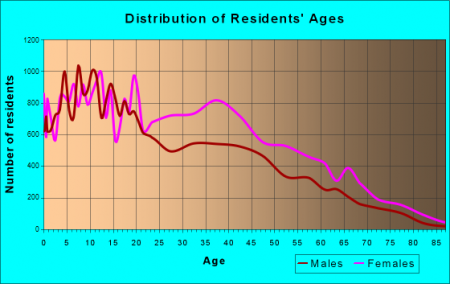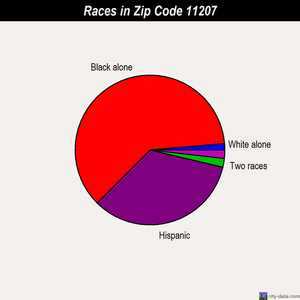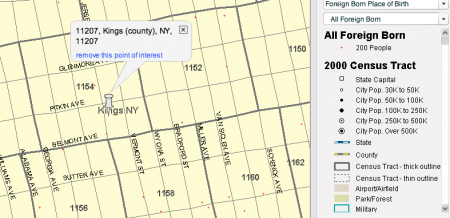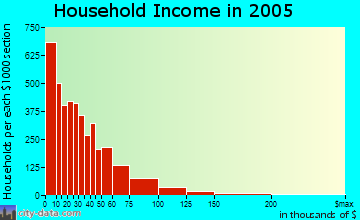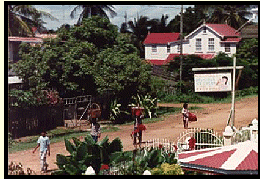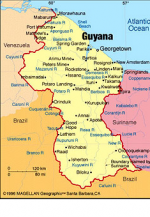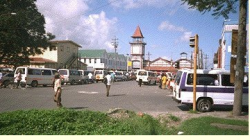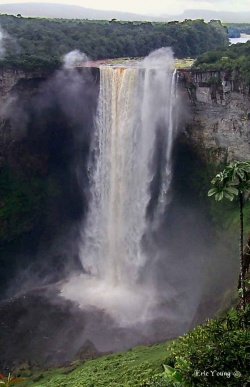User:Nickeitta LeungFrom The Peopling of New York City
Who am I?My StoryI am Nickeitta Leung, a nineteen year old freshman at Brooklyn College. I was born in Guyana, South America. When I was seven years old my mother and I immigrated to the United States where we settled in Jamaica, Queens for eleven years before moving to East New York, Brooklyn. I graduated from Benjamin Cardozo High School in Bayside, Queens. An aspiring lawyer, my years at Brooklyn College will be spent advancing myself as an exemplary student and preparing for law school [Brooklyn Law School perhaps]. My InterestsA majority of my time is spent at school or work. However, I often find the time to incorporate some of my interests into my busy schedule. I enjoy reading fictional novels, dancing, and dining with my friends. My Ideal East New YorkI reside on Vermont Street, a block in East New York, Brooklyn. An industrial neighborhood, many of the local businesses in East New York are auto shops and car dealerships. Therefore, my neighborhood is not quite residential. The various blocks are mucky, narrow, loud blocks tarnished with car grease and other aspects of the auto businesses around the vicinity. My block in particular is aligned by apartment buildings on both sides. Perpendicular to Vermont Street the J train line run directly above along Fulton Street. However, the most appalling feature of my block is its lack of diversity. My family is one of two African American families that reside on Vermont Street, a predominantly Hispanic block. Using the aspects of my block as a guide I have created a perception of what an ideal community should look like. My ideal community is a quiet and pleasant little suburban community. The blocks of this community are spotless and very wide. Brownstone family homes with ample yard space and many trees align the blocks of this community. The extremely green, neatly mowed lawns are well maintained and the buildings are not flawed by graffiti. Also the residents of this community are not disturbed by the unbearable sounds of trains traveling overhead. The various train lines in this community are underground lines. Residents of various races and nationalities occupy my ideal, diversified community in which the rate of violence is low. And last but certainly not least my ideal community is a unified community in which all the residents work together to help maintain the standards of such a community. Golden Door: A Film on Immigration to New York
The scene of Salvatore and Lucy’s arrival to America can be used to examine the process of immigration to New York City. Once they arrive on Ellis Island Salvatore and Lucy spend the quarantine period trying to pass numerous examinations to be admitted to the States. The examinations included a medical exam and an intelligence test that required immigrants to solve math problems and puzzles. The intelligence test was America’s way of preventing “feeble minded” individuals from entering the country. Neighborhood StatisticsThe following are statistics of zip code 11207/census track 1154 in Brooklyn, New York. The neighborhood population was 86,551 in 2000. Age Distribution in Zip Code 11207: Residents under 5: 179 Residents 5-14: 437 Residents 15-17: 114 Residents 18-34: 467 Residents 35-64: 645 Residents 65+: 110
Black/African American: 57,314 White: 7,534 Asian: 868 Two or More Races: 4,007 American Indian: 515 Native Hawaiian and Pacific Islander: 91 Some other race: 16,222
(48.2% of them are naturalized citizens) This zip code: 28.0% Whole state: 20.4%
Year of Entry for Foreign Born Residents:
This zip code: 36.2% Whole state: 14.6% Residents with income below 50% of the poverty level in 1999: This zip code: 21.1% Whole state: 7.4%
There to HereThere...The United States is not a stranger to immigration. As early as the nineteenth century the history and personality of the United States was shaped by massive waves of immigration from Eastern Europe. Today the culture of the United States continues to be influenced by immigrants from various parts of the world. Uprooted from their homes by violence, or by economic, social, or political pressures many immigrants come to the United States planning to settle down. Others, visitors to the United States, plan to leave but end up staying. A prime example is my family. I was born in West Coast Berbice,Guyana. Guyana is an Amerindian word meaning "the land of many waters. Guyana is located on the northern coast of South America. It is bordered by Venezuela on the west, Suriname on the east, Brazil on the south and the Atlantic Ocean on the north. A land that enjoys a friendly multicultural society Guyana is referred to as the land of "six peoples". Guyana’s population consists of Africans, Amerindians, Chinese, East Indians, Europeans and Portuguese who have all contributed in shaping Guyana's rich culture. However, as a result of massive migrations to the United States and Canada the number of Chinese, Europeans, and Portuguese living in Guyana are gradually declining.
Despite its location in South America, Guyana shares a similar culture to the islands of the Caribbean. Music: Popular genres of music in Guyana are Calypso, Soca and Chutney. Food: Also noteworthy is Guyana's distinctive national cuisine. Each ethnic group in Guyana have very distinct cultures however, there has been considerable cross-fertilization in terms of food. Some of the countries famous dishes are pepperpot, roti and curry (Indian heritage) and mettemgee (African heritage). Festivales: Some of the various festivals inhabitants of Guyana celebrate are Mashramani, Guyana’s independence day, Phagwah, a spring festival celebrated by the Hindu population and Diwali, the Hindu Festival of Lights. Notable Landmarks of Guyana: St. George's Cathedral Demerara Harbour Bridge Kaieteur Falls: Stabroek Market
The People of Guyana: My Parents My mother Dennise is an Afro-Guyanese from West Coast Berbice, Guyana. One of eleven children she graduated from Kwakwani High School before enlisting in the Guyana Defense Force where she met my father, a Sargent in the Guyana Defense Force at that time. My father is a mixed Guyanese (half black half Chinese) from Georgetown, Guyana. My mother was an exemplary officer of the Guyana Defense Force. Within two years of service she rise to the rank of Corporal. In 1988 my mother was forced to take a leave of absence in order to give birth to me. However, after staying at home for a year my mother decided that she would prefer to stay at home and raise me. So after five years of service to the army my mother resigned. My father served twenty years in the Guyana Defense Force before leaving to become a narcotics officer. When my father first obtained this job my mother was hesitant about it. She claimed that the job of a narcotics officer could be very dangerous at times. However, she eventually became very accepting of my father’s job as a narcotics officer when she learned of the many perks of the job; one in particular Visitors Visas to the United States. As a result of my father’s job as a narcotics officer he obtained Visitors Visas to the United States for the family. To...My mother had always talked of visiting her mother and sister who were living in Cambria Heights Queens, New York. So when she was finally given that opportunity my mother and I packed and left for the United States in August 1997. Intentionally we had planned to stay only a month in the United States but were granted six months by the immigration officer, so my mother extended our vacation. Unfortunately, during our vacation my grandmother, a diabetic, fell into a coma. Therefore, our vacation was extended again for an additional six months. Given that our vacation was constantly extending my aunt thought that it was best to enroll me in elementary school. So in January 1998 I started school at the Roy Wilkins Elementary School. I assimilated to American culture very quickly and did extremely well in school. So my aunt who became aware of my potential and promise to academic excellence convinced my mother to reside permanently in the United States. My aunt thought that it would be heartbreaking if I had to leave all the opportunities I had in the United States, so my mother an I decided to settle permanently in the United States. Here...The following year my father came to the United States to visit and continued to visit frequently until 2000 when he came to live with us permanently. When my father came to America permanently my parents and I moved from my aunt's house in Cambria Heights, Queens to Jamaica, Queens. We settled in Jamaica, Queens for the next seven years. In August 2007 I moved to East New York, Brooklyn where I currently reside. Midterm EssaysQuestion #1: Berger – Describe how specific neighborhoods have shifted populations overtime. Give two examples of different immigrants in different neighborhoods. New York City is a cosmopolitan metropolis renowned for its culturally diverse population and the amalgamation of its residents. Despite the assimilation of various ethnic groups in the city, certain ethnic groups are concentrated in certain parts of the city. For example, Richmond Hill, Queens is primarily populated by Indians from Guyana and Trinidad and Tobago whereas Astoria, Queens is well-known for its Greek population. However, the “ethnic boundaries” of various neighborhoods have shifted overtime. Two prime examples are East Harlem and Douglaston-Little Neck, Queens. In 1930 East Harlem had a predominant Italian population, populated by 80,000 Italians. However, “as a result of New York City’s accelerating ethnic mobility, Italian East Harlem is down to a relative handful of Italians”(Berger). A new Spanish Harlem as a result of an influx of Puerto Rican residents and more recently Mexicans and Dominicans has replaced Italian East Harlem. This shift in population occurred as a result of (1) the mobilization of Italians socially. Many Italians moved out of tenements and brownstones in East Harlem to Brooklyn, Queens and the suburbs, as many became wealthy professionals. (2) Various push factors of the island of Puerto Rico led to Puerto Ricans’ immigration to East Harlem. As a result of the economic crisis in Puerto Rico many Puerto Ricans migrated to East Harlem during the 1920s and 1940s. However, an increase in crimes and drugs in the 1970s and 1980s caused many Puerto Ricans to leave East Harlem thus shifting the population again from a Puerto Rican majority to an overwhelming Mexican and Dominican neighborhood. Nevertheless, as a result of recent gentrification of the neighborhood many professional Puerto Ricans are moving back to “El Barrio” in order to maintain the Puerto Rican culture in East Harlem. Douglaston and Little Neck are known to be overwhelmingly affluent, white European neighborhoods. Mainly Irish, Italian, German and Jewish residents populate these two neighborhoods of Queens. However, a recent influx of Asians primarily Koreans and Chinese immigrants is changing the ethnic makeup of these neighborhoods. “The number of Asians living there [Douglaston-Little Neck] has more than doubled in fifteen years as the city’s Korean and Chinese immigrants become doctors, bankers, hospital administrators, and entrepreneurs and leave their original beachheads in Chinatown or Flushing” (Berger). But what has led to this shift in population? Similar to Italians of East Harlem, the mobilization of Europeans socially is a contributing factor in the shift of Douglaston and Little Neck’s populations from an overwhelmingly white population to an increasing Asian population. The latter generations of Europeans become professionals instead of merchants and often choose to reside in Long Island instead of Little Neck. Therefore, having no one to pass down their businesses to many older Europeans are forced to sell their businesses to Korean migrants in the neighborhood and often many move. Also various pull-factors such as high performing schools have contributed to the increase of the Asian population in Douglaston and Little Neck. Very favorable of education, many Asian immigrants are drawn to these two neighborhoods in order to enroll their children into the schools of these neighborhoods. Question #2: Glazer & Moynihan - Pick one group and describe its assimilation process. Has this group truly melted in the pot? The over-population of Italy led to a mass migration in the 1870s of Italians to the United States as many Italians tried to escape low wages and high taxes in Italy. The earliest Italian immigrants to the United States were northern Italians. However, by the 1900s, even the poorer, more conservative southerners of Italy were immigrating to the United States. Most Italian immigrants, who were primarily men between the ages of eighteen and forty-five, had no intentions of staying in the United States permanently. These men were proletarians from rural communities with very little education, and only wanted to obtain a job in the United States in order to save enough money so that they can provide a better life for their wives and children when they returned to Italy. Expecting their stay in America to be brief, Italian immigrants lived as inexpensively as possible under conditions that native-born families considered intolerable.The new immigrants usually settled into cities such as New York City and Chicago where they developed Italian neighborhoods which slowly grew as more Italian immigrants arrived. Nevertheless, whether they settled permanently or not Italians faced overwhelming prejudice and isolation from American citizens who forced them to assimilate into U.S customs. Many Italians learned to speak English and adapted various aspects of American culture. However, Italian immigrants did not truly melt into the pot. Geographically concentrated in the same areas, Italians retained distinguished characteristics of their culture. Italians mobilize to preserve their culture while in the Unites States. Many Italians established their own shops and businesses in Italian neighborhoods. New arriving Italian immigrants also brought Italian dance, music and food, with them to the United States, which ironically U.S citizens adapted. Today Italian culture is a major part of American culture. Question #3: Foner - Describe one similarity and one difference between the two waves of immigrants to New York City in term of how they adapted to New York life. Between 1880 and 1920 New York City was affected tremendously by a wave of Eastern European Jews and Southern Italian immigrants. “The influx [of Eastern European immigrants] changed the way New Yorkers lived, the shape of their institutions, the flavor of their politics, the very food they ate” (Foner). Today the “history and personality” of New York City is being transformed again by a “new wave” of immigrants. However, unlike the “old wave” of immigrants who were mostly Eastern Europeans, the “new wave” of immigrants is migrants from the Dominican Republic, China, Mexico, and Jamaica. Even though the two waves of immigrants are from different regions of the world their reasons for immigrating to New York City are similar. Many migrated to New York City as a result of the population growth in their native land, to escape persecution or the effects of the globalization of capitalism. However, their transition to life in the city was not so comparable. The “old wave” and “new wave” of immigrants adapted to life in New York City differently. One prime difference in the lives of earlier immigrants and more recent immigrants is their living conditions. Earlier immigrants lived in crowded, unsanitary tenements on the Lower East Side whereas “many recent ones [immigrants] now start out in decent housing in lower-middle class neighborhoods” (Foner) throughout the five boroughs. Foner notes the discrepancy in education level of the immigrants as the source of this difference. Unlike recent immigrants who arrived with college degrees and various technical skills, the earlier immigrants had little education and few skills therefore recent immigrants found “jobs that can support a middle or lower-middle class lifestyle from the start” (Foner). Even though the transition to life in New York City of the two waves of immigrants differed in various aspects their transition was also similar in some ways. For example, both the “new wave” and “old wave” of immigrants “clustered in ethnic neighborhoods with their own kind” (Foner). Upon arrival to New York City both groups of immigrants were drawn to neighborhoods in which fellow immigrants already resided. Fellow immigrants were able to provide new arrival immigrants with support thus easing their transition to life in New York. Question #4: Discuss multiculturalism, cultural pluralism and assimilation. Multiculturalism, Cultural Pluralism and Assimilation are three ideologies of immigration. Assimilation is the oldest ongoing idea in the United States. This theory best represented by the “Melting Pot” metaphor is the process by which individuals or groups absorb and adopt the language, culture, and ethnic identity of a dominant group in society. For example many early immigrants were forced to adapt U.S culture by learning English. Simply put assimilation is a process in which various ethnic groups of a society become indistinguishable from each other. However, beginning in the late 1950s and 1960s, this melting pot metaphor was challenged by many ethnic groups. Refusing to acknowledge that they have abandoned their own culture and melted into U.S culture these individuals argued for a plural society. Thus the ideology cultural pluralism was established. Cultural pluralism refers to the interaction of various groups in society however each group maintains their cultural differences. In a plural society different cultures coexist and are tolerant of each other. A prime example of this ideology of cultural pluralism is demonstrated in Ditmas Park, Brooklyn. Ditmas Park is a culturally diverse neighborhood comprised of White, Black, Asian and Latino residents who all mingle together despite their cultural differences. Similar to cultural pluralism multiculturalism refers to the various cultural or ethnic groups within a society. It is an ideology advocating that several different cultures (rather than one national culture) can coexist peacefully and equitably in a single country |

